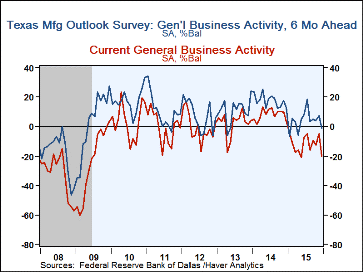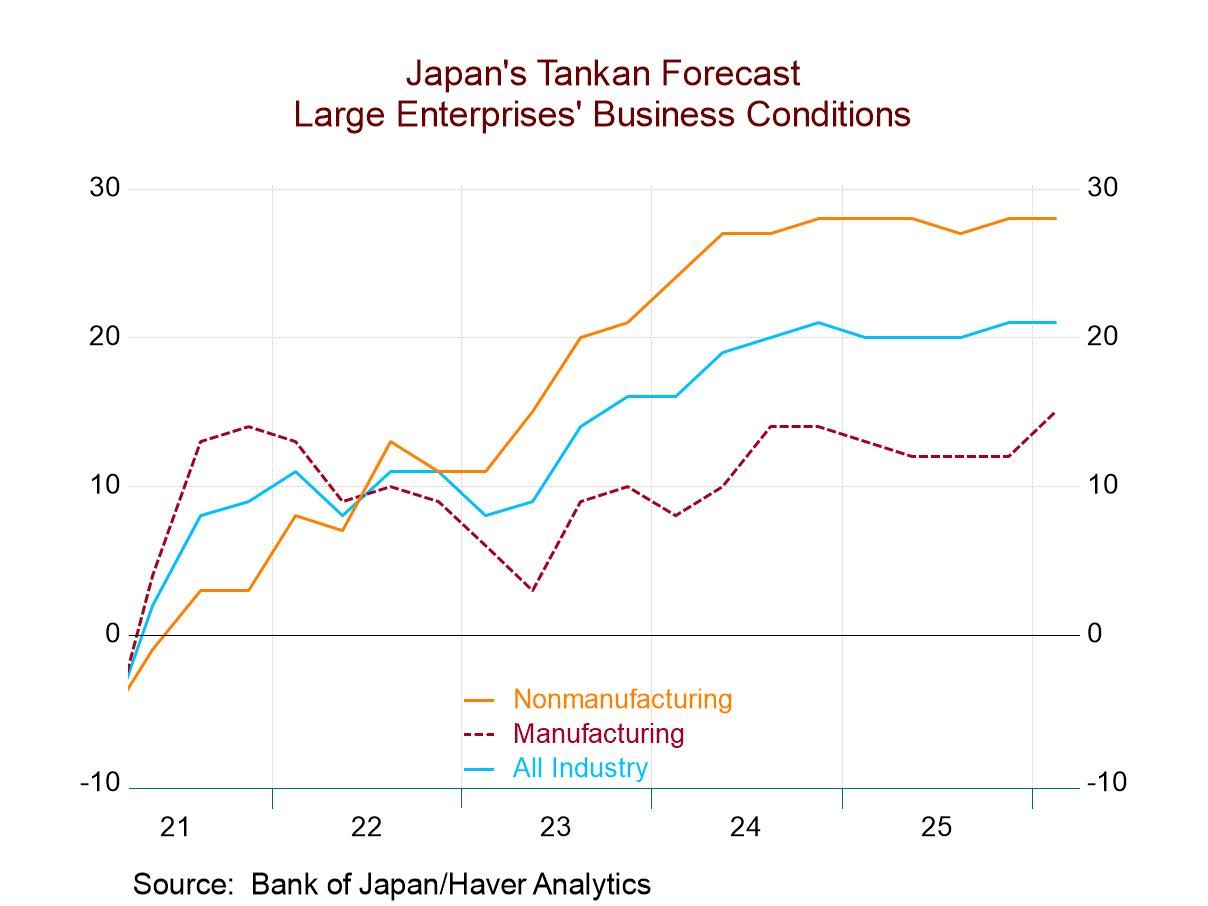 Global| Dec 28 2015
Global| Dec 28 2015Dallas Fed Factory Sector Activity Index Weakens
Summary
The Federal Reserve Bank of Dallas reported that its general activity index of factory sector activity weakened for December to -20.1% from -4.9% in November. The latest reading is still marginally firmer than the May low of -20.8%. [...]
The Federal Reserve Bank of Dallas reported that its general activity index of factory sector activity weakened for December to -20.1% from -4.9% in November. The latest reading is still marginally firmer than the May low of -20.8%. The current weakness was most evident in the pace of new orders and in prices. The growth rate of new orders was declining at 14.3% more of respondents than it was increasing and compared to -7.3% in November. Prices received for finished goods fell in December at 15.9% more companies than at those experiencing an increase in prices received, weaker than November's -12.1% balance.
However, some aspects of manufacturing activity improved in the December survey. Production improved at 13.4% more companies than those showing a decline versus just a 5.2% balance in November. Employment had a modest improvement, with 12.8% more companies adding employees instead of cutting them, compared with 11.6% in November. Wages and benefits and hours worked also had gains, remaining distinctly in positive territory.
Despite the positive moves in some measures of manufacturing, the outlook for overall business activity in the next six months fell into negative territory in December, the first such reading below zero since April. This latest general activity index was -1.4% compared to +7.3% in November. All of the major six-months expectations readings were positive, but lower than in November. Production is expected to increase at a net of 29.8% of companies, compared to 34.1% in November. The slowing of employment growth is more distinct, with 18.5% more respondents looking for their employment to increase than expect to cut it, down from 24.6% in November. New orders are expected to grow more rapidly at a net of 16.4% of companies, compared to 24.3% in November.
The diffusion indexes are calculated as the percentage of total respondents reporting increases minus the percentage reporting declines. Respondents this month totaled 116 manufacturing companies in Texas; they are asked whether output, employment, orders, prices and other indicators increased, decreased or remained unchanged over the previous month; the survey data were collected December 14-22. The data can be found in Haver's SURVEYS database.
| Dallas Federal Reserve Manufacturing Survey (SA, Percent Balance) | Dec | Nov | Oct | Dec '14 | 2015 | 2014 | 2013 |
|---|---|---|---|---|---|---|---|
| General Business Activity Versus One Month Ago | -20.1 | -4.9 | -12.7 | 3.5 | -12.0 | 8.3 | 2.2 |
| Production | 13.4 | 5.2 | 4.8 | 16.4 | -0.6 | 14.6 | 9.8 |
| Growth Rate of New Orders | -14.3 | -7.3 | -7.7 | -4.0 | -12.5 | 4.7 | 0.1 |
| Number of Employees | 12.8 | 11.6 | 0.3 | 10.0 | 1.2 | 11.5 | 5.6 |
| Prices Received for Finished Goods | -15.9 | -12.1 | -9.5 | 4.2 | -8.8 | 8.3 | 2.9 |
| Business Activity in Six Months | -1.4 | 7.3 | 4.1 | 13.0 | 3.8 | 17.4 | 11.0 |
| Production | 29.8 | 34.1 | 34.3 | 33.1 | 31.1 | 42.7 | 37.1 |
| Future New Orders Growth Rate | 16.4 | 24.3 | 19.6 | 26.2 | 20.5 | 31.5 | 25.0 |
| Number of Employees | 18.5 | 24.6 | 19.1 | 20.2 | 15.3 | 28.6 | 23.1 |
| Wages & Benefits | 29.7 | 33.6 | 33.3 | 38.0 | 33.1 | 43.0 | 38.2 |
Carol Stone, CBE
AuthorMore in Author Profile »Carol Stone, CBE came to Haver Analytics in 2003 following more than 35 years as a financial market economist at major Wall Street financial institutions, most especially Merrill Lynch and Nomura Securities. She had broad experience in analysis and forecasting of flow-of-funds accounts, the federal budget and Federal Reserve operations. At Nomura Securities, among other duties, she developed various indicator forecasting tools and edited a daily global publication produced in London and New York for readers in Tokyo. At Haver Analytics, Carol was a member of the Research Department, aiding database managers with research and documentation efforts, as well as posting commentary on select economic reports. In addition, she conducted Ways-of-the-World, a blog on economic issues for an Episcopal-Church-affiliated website, The Geranium Farm. During her career, Carol served as an officer of the Money Marketeers and the Downtown Economists Club. She had a PhD from NYU's Stern School of Business. She lived in Brooklyn, New York, and had a weekend home on Long Island.









